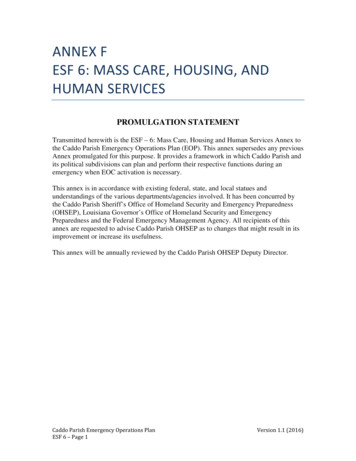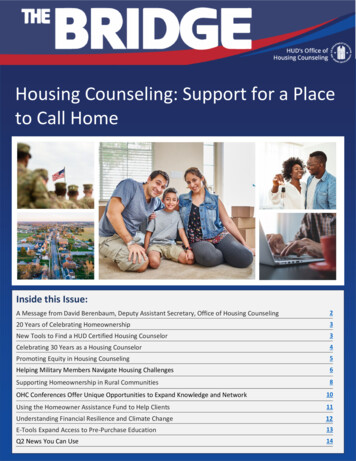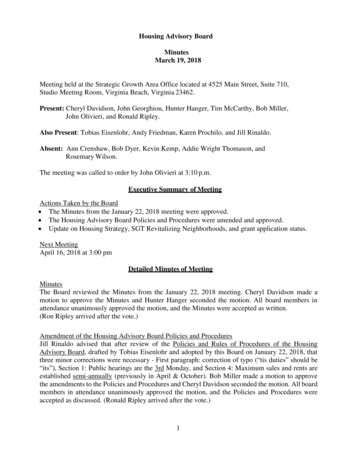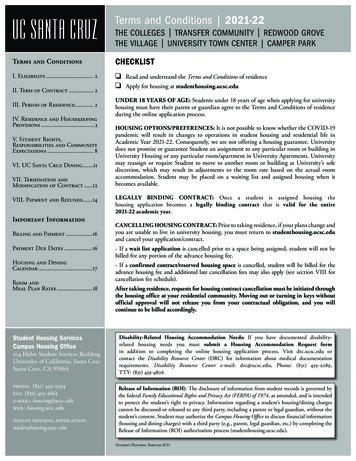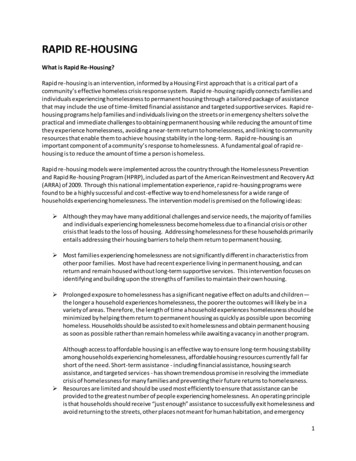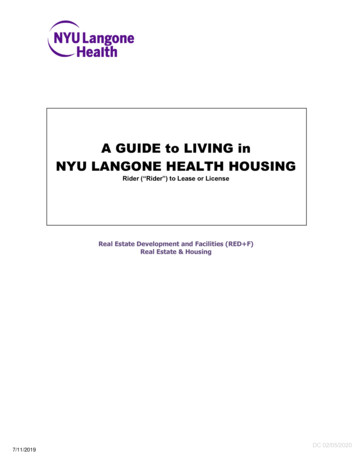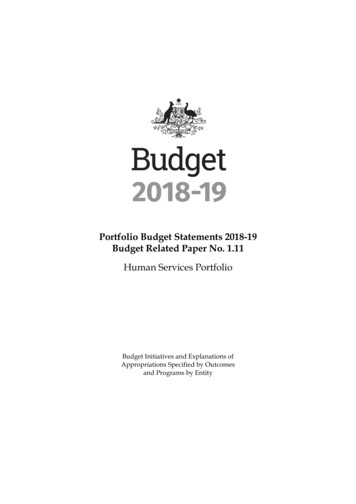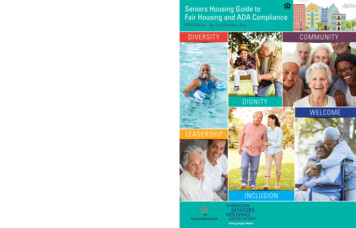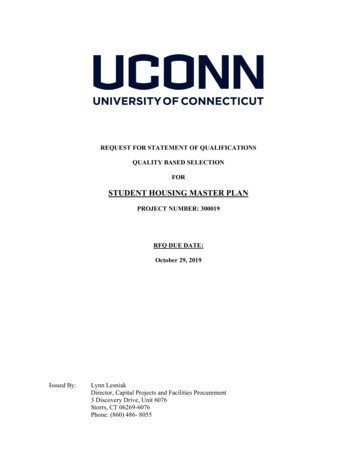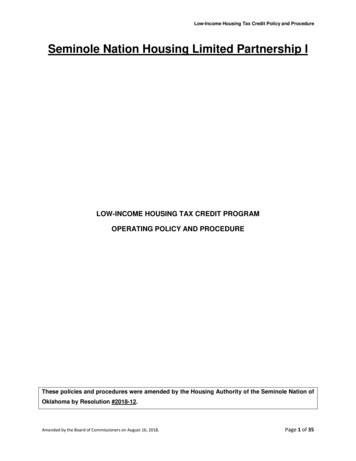
Transcription
Housing, Health and Human ServicesHousing Development Goals To develop, maintain, and preserve affordable housing and promote equal housingopportunity through the acquisition, renovation, and/or construction of affordable housingunits. To develop affordable housing programs for persons with disabilities, homeless, andelderly which provide or have access to supportive services to facilitate independent living. To locate affordable housing as close as possible to employment opportunities, publictransportation and community services. To promote economically balanced communities by developing affordable housing in allparts of the County. To maintain the quality of existing units in the Fairfax County Rental Program as they agein order to promote the stability of the neighborhoods in which they are located. To maximize the use of federal, state, non-profit and private sector housing developmentprograms and funding.Health and Human Services Goals To provide community services as an alternative to institutional placements. To provide facilities and services which will enhance the physical health, mental healthand social well-being of County citizens. To establish additional group homes which promote integration within the community forpersons who have developmental disabilities. To provide facilities and services that will assist in the rehabilitation of individualsrecovering from alcohol and drug abuse. To establish additional treatment facilities in new growth areas to accommodate thehuman services needs for local residents. To continue partnerships with Virginia Department of Medical Assistance Services formaximizing Medicaid revenues to fund clinical residential supports. To continue a commitment to privatization by working collaboratively with private serviceprovider agencies for the delivery of residential support services. To support, promote and provide quality child care and early childhood educationservices in Fairfax County.Fairfax County, Virginia: FY 2020 - FY 2024 Advertised CIP - 113
Housing DevelopmentPROGRAM DESCRIPTIONThe primary mission of the Department of Housing and Community Development (HCD) is to act as thedevelopment and administrative agency for the Fairfax County Redevelopment and Housing Authority(FCRHA) and the Board of Supervisors in meeting the housing and community development needs of theCounty's low and moderate income residents.LINK TO THE COMPREHENSIVE PLANFairfax County's Comprehensive Plan has established a number of objectives andpolicies in order to: Encourage the provision and promote the availability of affordable housing inall parts of the County. Support the Fairfax County Redevelopment and Housing Authority in itsmission to plan, acquire, develop and maintain affordable housing usingfederal, state and county programs. Increase the supply of affordable housing units each year to serve the full rangeof incomes of households and special populations, including the physically andmentally disabled, the homeless, and the low-income elderly. Ensure workforce housing is provided in the county’s mixed-use centers,including Tysons Urban Center, suburban centers, community businesscenters and transit stations areas. Promote the development of multi-family housing in both mixed-use Centersand existing residential use areas, and develop adequate transitional housingfor homeless families. Retain existing below market rental housing through acquisition, rehabilitationassistance and other subsidies.Source: 2017 Edition of the Fairfax County Comprehensive Plan, Policy Plan Element, Housing, EconomicDevelopment (amended through 3-4-2014), and Human Services Sections (amended through 3-4-2014), asamended.PROGRAM INITIATIVESIn January 2010, the Board of Supervisors endorsed an affordable housing policy, known as the “HousingBlueprint”. The Housing Blueprint represented a shift in emphasis for the County’s affordable housingpolicies in response to the recession at the time. The Housing Blueprint focuses on providing housing forthose with the greatest need, including homeless families and individuals, persons with disabilities, andpeople with extremely low-incomes. The Housing Blueprint also emphasizes partnering with the County’snon-profit community to provide creative affordable housing solutions, refocusing of existing resources, andfostering the development of workforce housing through land use policies and public/private partnerships.Fairfax County, Virginia: FY 2020 - FY 2024 Advertised CIP - 114
The Housing Blueprint has four goals: To end homelessness in 10 years;To provide affordable housing options to those with special needs;To meet the affordable housing needs of low-income working families; andTo produce sufficient Workforce Housing to accommodate projected job growth.Key to achieving the metrics set forth in the Blueprint is the FCRHA’s pipeline of affordable housingdevelopment projects, including: the completed construction of “Kate’s Place”, which included six units ofpermanent supportive housing for formerly homeless households (Springfield District); the completedrenovation of the Lincolnia Center (Mason District), and the Residences at the Government Center(Braddock District). Projects currently underway include the construction of the Lewinsville Center(Dranesville District), Murraygate Village Apartments Renovation (Lee District), Oakwood (Lee District),Little River Glen Expansion (Braddock District), One University (Braddock District), and North Hill (LeeDistrict).Also critical to the success of the Housing Blueprint are the following initiatives:Workforce Housing Policy: Created by the Board of Supervisors in 2007, Fairfax County’sWorkforce Housing policy is a proffer-based incentive system designed to encourage the voluntarydevelopment of new housing affordable to a range of moderate-income workers in Fairfax County’shigh-rise/high-density areas. The Comprehensive Plan provides for a density bonus of up to oneunit for every workforce unit provided by a developer, with the expectation that at least 12 percentof units in new developments be affordable or workforce housing. The Workforce Housing policyalso provides for the administrative tools for the long-term administration of proffered workforceunits, and addresses issues such as unit specifications, price and financing controls, covenantsand occupancy. As of October 2018, approximately 8,410 Workforce Dwelling Units (WDU) havebeen committed by private developers in rezoning actions approved by the Board of Supervisorsand a total of 1,247 units have been constructed.Affordable Housing Preservation: Preservation of affordable rental housing has long been aconcern of the Board of Supervisors and the FCRHA. The stock of privately-owned subsidizedunits and non-subsidized rental housing with modest rents in the County has been declining asowners repositioned their properties in the market, prepaid their federally subsidized mortgages,opted not to renew their Section 8 project-based contracts or terminated their participation at theend of the control period for their FCRHA bond-financed properties. The centerpiece of the Board’sPreservation Initiative was the creation of the “Penny for Affordable Housing Fund”. For fiscal years2006 through 2009, the Board dedicated revenue commensurate with the value of one cent fromthe Real Estate tax rate to affordable housing preservation. In FY 2010, the Board reduced ThePenny for Affordable Housing Fund by 50 percent. The Affordable Housing Preservation Initiativehas preserved a total of 3,016 affordable housing units as of the end of FY 2018.Affordable Dwelling Unit Program: In addition to the Workforce Housing policy described above,the County adopted the Affordable Dwelling Unit (ADU) program in 1990 as part of the ZoningOrdinance. The ADU program requires developers of certain housing developments to set asideup to 12.5 percent of the units as ADUs (6.25 percent for multifamily rentals) in return for additionaldensity granted at the time the development is built. The FCRHA has the right to acquire one thirdof the for-sale ADUs and to lease up to one third of the rental ADUs. The remaining units are soldor rented to moderate income households. As of October 2018, a total of 2,791 units (1,385 rentaland 1,406 for-sale units) have been produced under the ADU program. FCRHA has acquired 152of the for-sale units, which are maintained as permanent affordable rental housing.Lack of affordable housing in Fairfax County: Fairfax County remains one of the highest cost areas forhousing in the nation. Over the last decade, Fairfax County has experienced unprecedented increases inthe cost of for-sale housing and a significant loss of affordable rental housing. A continued reasonablyhealthy job market and above average housing prices compared to the rest of the country continue to makeFairfax County a profoundly challenging housing market for low-and moderate-income working households.This is particularly true for new entrants into the housing market who are coming to pursue jobs in FairfaxCounty. According to Virginia Tech Center for Housing Research data prepared for the Fairfax County FiveYear Consolidated Plan for FY 2016-2020, the total current affordable housing gap for low- and moderateincome renters in the county (those earning 80 percent of the Area Median Income (AMI) and below) isFairfax County, Virginia: FY 2020 - FY 2024 Advertised CIP - 115
approximately 31,630 units. For low- and moderate income buyers, the gap is approximately 27,900 units.This gap in housing affordability can affect the ability of employers, including the County, to attractemployees crucial to the health and safety of the community, as well as to the County’s growth andcontinued economic prosperity.Over the next 15 years the need for affordable housing options will grow, as the County is projected to add62,184 households, of which 18,622 are expected to earn 80 percent of AMI and below. A George MasonUniversity workforce housing study, commissioned by the FCRHA, found that Fairfax County’s economicvitality is “inextricably tied” to its response to the need for affordable workforce housing, and that theCounty’s continued growth is “highly dependent” on the availability of housing that is “affordable to workersfrom the full spectrum of the economy”. The report concluded that “failing to plan for a balanced supply ofhousing in the future will reduce the County’s opportunities for economic growth”, resulting in the outmigration of businesses, reduced availability of personal and business services, and a decline in livability.According to the 2017 US Census Bureau American Community Survey, there are an estimated 71,645households in Fairfax County earning less than 50,000 per year, or about 43 percent of the area medianincome for a family of four ( 117,200). Also according to Census data, there are an estimated 77,177persons living below the poverty level in the County. In Fairfax County, the National Low Income HousingCoalition Out of Reach 2018 report found that an annual salary of 71,720 is needed to afford a twobedroom apartment at the U.S. Department of Housing and Urban Development’s (HUD) Fair Market Rent(FMR) of 1,793 – approximately 61 percent of the AMI for a family of four. According to the report, aminimum wage earner would have to work nearly five full-time jobs to afford a two-bedroom unit at the FMRin Fairfax County.Construction of Affordable Housing: Lewinsville Redevelopment (Dranesville District): This project was awarded 9 percent of LowIncome Housing Tax Credits (LIHTC). The project includes the demolition of the current facility andconstruction of two buildings, which will provide: 82 units of “Independent Living” housing for theelderly; space for the Health Department’s Adult Day care facility; two child day care centers; andan expansion of services of the existing Senior Center programs operated by the Department ofNeighborhood and Community Services. This project is being developed through a PPEA.Construction of the residential facility was completed in October 2018, the day care/senior facilityis currently in construction and is planned for occupancy in the summer 2019, and final completionof the full project is scheduled for fall 2019. Lincolnia Residences Renovation (Mason District): The building complex provides space for threeseparate operations; Senior Housing and Assisted Living managed by the HCD, a Senior Centeroperated by the Department of Neighborhood and Community Services, and an Adult Day HealthCare Center managed by the Health Department. The Senior Housing and Assisted Living portionis comprised of 26 affordable apartments, 52 beds of licensed assisted living, common areas forthe residents, and a commercial kitchen, which supports all on-site activities. Phase I of theLincolnia Residences Renovation project was substantially completed in FY 2016. The renovationincluded extensive interior renovations and replacement of the HVAC system, emergencygenerator, fire pump and alarm system upgrades, roof replacement, elevator modernization,numerous modifications to improve accessibility, and various site enhancements, includingdrainage improvements. Phase II of the original project scope, includes trim work, cabinetryreplacement, water heaters replacement, addition of electrical circuits, and other miscellaneousenhancements. This work began in November 2018 and is expected to be completed by July 2019.Homeownership: The FCRHA facilitated home purchases for 27 low- and moderate-income FairfaxCounty first-time homebuyers in FY 2018.Rehabilitation of FCRHA-Owned Properties: To ensure that FCRHA-owned properties are maintainedto community standards, the below rehabilitation projects were completed or underway in FY 2018.Fairfax County, Virginia: FY 2020 - FY 2024 Advertised CIP - 116
Fairfax County Rental Program: Mount Vernon Gardens (34 units): Replaced roof, replaced interior railings, improved the HVACsystem by adding new individual zone values, and replaced windows. Penderbrook (48 units): Replaced failing sub-flooring. Little River Glen (120 units): Balcony repairs.Capital Fund Program/Rental Housing Demonstration Rehabilitation and Modernization: Audubon (45 units): Replacement of boiler and water heater. Rosedale Manor (96 units): Replacement of water heaters, wall heaters, sidewalks, stairway railsand retaining wall. Barros Circle (43 units): Replacement of roofs, water heaters, fencing, HVAC systems, ranges,range hoods and hardwood flooring. Old Mill (47 units): Replacement of water heaters and office HVAC. Newington Station (36 units): Replacement of bathroom electrical circuits. The Green – West Glade (50 units): Replacement of exterior lighting, common area interior lightingfixtures and in-unit lighting fixtures.Rental Assistance Demonstration (RAD) Conversion:In FY 2017, the FCRHA conducted Capital Needs Assessment studies on all of its federal Public Housingproperties to facilitate the conversion from the federal Public Housing program to the federal Project-BasedSection 8 program, which has been a more stable source of funding. All RAD conversions were completedby December 2017.Multifamily Rental Housing and Tenant Subsidy Programs: In FY 2018, the average income ofhouseholds served in the FCRHA’s major multifamily affordable rental housing and tenant subsidyprograms, namely, the Federal Housing Choice Voucher (HCV) and Federal Project Based Voucher (PBV)Rental Assistance Demonstration (RAD) programs, the Fairfax County Rental Program (FCRP), and theBridging Affordability program was approximately 26,127, or 25 percent of AMI for a family of three (theaverage household size in these programs). This meets the HUD definition of “extremely low income”. Atotal of 18,096 individuals were housed in the HCV and PBV-RAD programs and FCRP in FY 2018.Affordable Housing Preservation: In FY 2018, HCD and the FCRHA used HOME and CDBG funds topreserve a total of 16 units via the financing of purchases by nonprofit affordable housing providers. Allnonprofit units preserved during FY 2018 have affordability periods of a minimum of 30 years. From April2004 through June 2018, a total of 3,016 affordable housing units were preserved in Fairfax County. Thisis three times the Board of Supervisors’ original 2004 goal of preserving 1,000 units.HCD and the FCRHA produce affordable housing via three principal means: 1) direct acquisition ofaffordable housing; 2) financing of acquisitions by qualified nonprofit or for-profit developers; and3) capital construction. Financing is derived from a variety of sources including the Affordable HousingPartnership Program (AHPP), the FCRHA Tax-Exempt Bond Program, Low Income Housing Tax Creditsand other, local, state and federal funds. Affordable units developed; acquired or financed by HCD/theFCRHA may serve a variety of residents, including very low income single individuals, as well as personswith disabilities, families and senior citizens.Highlights of the FCRHA's preservation and other affordable housing activities in FY 2018 include: Pathway Homes, Inc. (7 units; Mason, Braddock, Providence and Hunter Mill Districts): The FCRHAprovided financing in a total amount of 1,098,000 ( 622,811 CDBG and 475,189 HOME,awarded under HCD-issued RFPs) to Pathway Homes to acquire seven 1-bedroom condominiumunits to provide affordable housing and supportive services to individuals who are homeless orprecariously housed with incomes at or below 30 percent of AMI and who have special needsrelated to mental illness, co-occurring substance abuse disorders, or intellectual disorders.Supportive services will be provided by Pathway Homes through a partnership with the FairfaxFalls Church Community Services Board (CSB). At some of these units, previously awarded ProjectBased Vouchers are being used to subsidize unit rents.Fairfax County, Virginia: FY 2020 - FY 2024 Advertised CIP - 117
Wesley Housing Development Corporation. (126 units; Mount Vernon District) The FCRHAapproved a Housing Blueprint Loan of 7.4 million for the new construction of 126 units of lowincome housing at 60 percent of AMI or below, right next to the Huntington Avenue Metro Stationin Alexandria. The project will also house Wesley Housing’s headquarters when complete, andprovide services to its tenants for job skills and financial management. Good Shepherd Housing and Family Services (9 units; Lee District): The FCRHA provided a totalof 1,133,260 of funding for the acquisition of housing units, including 713,820 of CDBG funding(awarded to GSH under the CCFP and the HCD-issued RFP) and 419,440 of HOME funding(awarded under the HCD-issued RFP and CHDO set-aside). These units are being used asaffordable rental housing for families earning at or below 50 percent of AMI. The Lindsay Hill (55 units, Mount Vernon District) for the elderly population of Northern Virginia. FCRHA (5 townhouse units; Sully District): Five townhouse units in the Discovery SquareDevelopment were purchased in the Sully District for use in the Fairfax County Rental Program toprovide affordable housing for households with incomes at or below 70 percent of AMI.CURRENT PROJECT DESCRIPTIONS1. ADA Compliance - Housing (Countywide): 2,541,000 is the current estimated cost for theimprovements/modifications needed for FCRHA properties in order to comply with the January 28,2011 Americans with Disabilities Act settlement between the Board of Supervisors and the Departmentof Justice. The following projects were inspected and identified as having deficiencies: Beacon HillGroup Home; Braddock Glen; Leland House Group Home; Minerva Fisher Hall Group Home;Mondloch House Group Home; Patrick Street Group Home; 4500 University Drive (FCRHA BoardRoom/Property Maintenance and Improvement Division Office); Rolling Road Group Home; SojournHouse Group Home; 3700 Pender Drive; and Wedgewood Apartments. FY 2020 funding of 50,000has been included to continue to implement improvements. Additional funds will be identified annually.2.Autumn Willow Senior Housing (Springfield District): The project is being developed through thePPEA process. The project scope is to develop 150 units of affordable independent senior housingon the 10.88 acres County-owned site located at the intersection of Stringfellow Road and AutumnWillow Drive. No funding has been identified for this project.3.Crescent Redevelopment (Hunter Mill District): 1,299,000 is available to facilitate theredevelopment of the county-owned Crescent Apartments site and the properties within the Lake AnneVillage Center. The Crescent Apartments, a 181-unit apartment complex acquired by the County inFY 2006, is located adjacent to Lake Anne in Reston, near the new Metro Silver Line and the RestonTown Center. The property is managed by the FCRHA on behalf of the Board of Supervisors. Aphysical needs assessment study was completed to identify improvements that are needed to ensurethe property’s continued sustainability in its current form.4.Housing at Route 50/West Ox Road (Sully District): 8,500,000 is currently estimated to be requiredfor the construction of 30 units of affordable housing on land owned by the County. At this time, it isunknown as to what population this project would serve. Potential options identified as prioritypopulations in the Housing Blueprint include formerly homeless persons, including homeless veterans,those with disabilities and other special needs, as well as low-income working households. It shouldbe noted that the Capital Improvement Program has, in the past, included plans for a “Magnet Housing”project on this site, which was anticipated to include approximately 30 units of housing coupled with atraining facility. While the training facility was ultimately determined to be not feasible, the site remainsa critical and available opportunity for the development of new affordable housing. Federal HOMEInvestment Partnership (HOME) funds have been expended on this site for pre-development purposesand environmental remediation.Fairfax County, Virginia: FY 2020 - FY 2024 Advertised CIP - 118
5.Lewinsville Redevelopment (Dranesville District): 19,053,386 has been approved for theredevelopment of the Lewinsville Center. The project includes the demolition of the existing facilityand construction of two buildings. The first building will provide 82 units of affordable independentsenior housing units, which will be constructed and operated at no cost to the County using LowIncome Housing Tax Credits (LIHTC) under a long term ground lease agreement. The second buildingis funded by the County and will include the Health Department’s adult day care facility, two child daycare centers, and the expansion of services of the existing Senior Center programs operated by theDepartment of Neighborhood and Community Services. In January 2015, the Board approved aComprehensive Agreement with Wesley Hamel. Wesley Hamel was awarded LIHTC for the affordableindependent senior units in June 2015. Construction of the residential facility was completed inOctober 2018, the day care/senior facility is currently in construction and is planned for occupancy inthe summer 2019, and final completion of the full project is scheduled for fall 2019.6.Lincolnia Residences Renovation (Mason District): 12,122,380 has been approved to renovate thebuilding complex, which provides space for three separate operations: Senior Housing and AssistedLiving managed by the HCD, a Senior Center operated by the Department of Neighborhood andCommunity Services, and an Adult Day Health Care Center managed by the Health Department. TheHousing portion is comprised of 26 units of affordable apartments for seniors, 52 beds of licensedAssisted Living, common areas for the Housing residents, and a commercial kitchen which supportsall on-site activities. The renovation includes replacement of the HVAC system and the emergencygenerator, extensive interior overhauls and upgrades of lighting and the fire alarm system, elevatormodernization, roof and fire pump replacement, numerous modifications to improve accessibility, andminor site enhancements. Funding sources available for this project included Elderly HousingPrograms Fund (Fund 40330), and proceeds from bond sales, as specified in the financing planapproved by the Board of Supervisors in FY 2014. Phase I of the Lincolnia Senior Center RenovationsProject was completed in FY 2016. Phase II, which includes trim work, cabinetry replacement, hotwater heater replacement, the addition of electrical circuits, and other miscellaneous improvementsbegan in November 2018 and is expected to be completed by July 2019.7.Little River Glen IV (Braddock District): 18,240,000 is estimated to be required for the constructionof 60 affordable independent senior housing units on land owned by the FCRHA. The building andsite design is in progress. Upon completion of schematic design and detailed cost estimates in May2019, a financing plan for the project will be developed to identify funding sources. Federal HOMEInvestment Partnership (HOME) funds have been expended on this site for pre-developmentpurposes.8.Mount Vernon Garden Apartments (Lee District): 802,000 has been approved to renovate the 34unit Mount Vernon Garden apartment complex. A Physical Needs Assessment study was completedin FY 2017. The assessment resulted in the identification of health and safety items that are neededto keep the property operational for the next 7 – 10 years. The scope of the rehabilitation will includecentral water heating system upgrades, roof replacement, limited electric system upgrades, hand railsand guardrails repair, and common area window replacement. Rehabilitation work is anticipated tobe completed in late FY 2019.9.Murraygate Village Apartments Renovation (Lee District): 40,866,000 has been approved toconduct extensive renovations of the 200-unit Murraygate Village apartment complex. Plannedrehabilitation will include replacement of central heating and cooling systems with individual HVACunits in apartments, electrical system upgrades, accessibility improvements, kitchen and bathroommodernization, other miscellaneous enhancements, and minor site work. Electrical upgrades werecompleted in June 2018. Full building renovations are began in January 2019 and are expected to becompleted in late 2020. Funding for the project is provided through: Penny for Affordable HousingFund (Fund 30300); Housing Trust Fund (Fund 40300), LIHTC, seller take-back note, first mortgage,and deferred developer fees.Fairfax County, Virginia: FY 2020 - FY 2024 Advertised CIP - 119
10. North Hill (Mount Vernon District): This project supports the development of the North Hill property, a33-acre site owned by FCRHA located at the intersection of Richmond Hwy and Dart Drive. The projectis being developed through the PPEA process. The FCRHA entered into an Interim Agreement withCHPPENN, a partnership of Community Housing Partners (CHP) and Pennrose. CHPPENN wasawarded LIHTC in June 2017. Approximately one third of the property will be sold to a developer tocreate 175 for-sale market rate townhomes. The rest of the property will be developed to create 219multifamily affordable and workforce units, and 60 affordable independent senior housing units, and a12-acre public park. The townhouse land sale proceeds will be used to fund the infrastructure neededfor the affordable rental development. Closing is anticipated for the fall 2019 with construction startingshortly after.11. Oakwood Senior Housing (Lee District): 800,000 has been identified for predevelopment activitiesassociated with the development of a 6.2 acre site owned by the FCRHA located at the intersection ofOakwood Road and Van Dorn Street. The site has the potential for the development of up to 150 unitsof affordable independent senior housing via the PPEA process. An unsolicited proposal has beenreceived to develop the property. The proposal calls for constructing 150 units of affordable seniorhousing. Two competing proposals were received in August 2018. Developer selection is underway.12. One University (Braddock District): 600,000 has been identified for predevelopment activitiesassociated with One University. This project is being developed through the PPEA process. The siteis located at the intersection of Route 123 and University Drive. An unsolicited proposal was receivedto redevelop the FCRHA property. The proposal calls for replacing the existing affordable housing(Robinson Square) and the existing FCRHA facilities. The proposed development will include up to240 units of affordable housing and 363 units (720 beds) of student housing. Two competing proposalshave been received and Developer selection is complete. The land use process is also underway.13. Rehabilitation of FCRHA Properties (Countywide): This is a continuing project to support therecurring maintenance and rehabilitation needs of FCRHA-owned properties. Resources for thisproject include: the Housing Trust Fund (Fund 40300), the federal Community Development BlockGrant (Fund 50800), and the federal HOME Investment Partnerships Program grant (Fund50810). HCD updates the needs of the FCRHA properties annually and prioritizes them by:accessibility modifications/improvements; energy efficiency improvements; site improvements, andmodernization. Properties that have been renovated or are in the process of being renovated are listedin “Rehabilitation of FCRHA-Owned Properties” section above. Projects that may be rehabilitated inFY 2019 have undergone Physical/Capital Needs Assessment studies. This effort does not includework to address Public Housing properties in need of significant renovation and conversion to aSection 8 rental subsidy platform under the federal RAD program. Properties requiring significantrenovation will be listed in future years.14. Stonegate R
Preservation Initiative was the creation of the "Penny for Affordable Housing Fund" . For fisc al years 2006 through 2009, the Board dedicated revenue commensurate with the value of one cent from the Real Estate tax rate to affordable housing preservation. In FY 2010, the Board reduced The Penny for Affordable Housing Fund by 50 percent.
